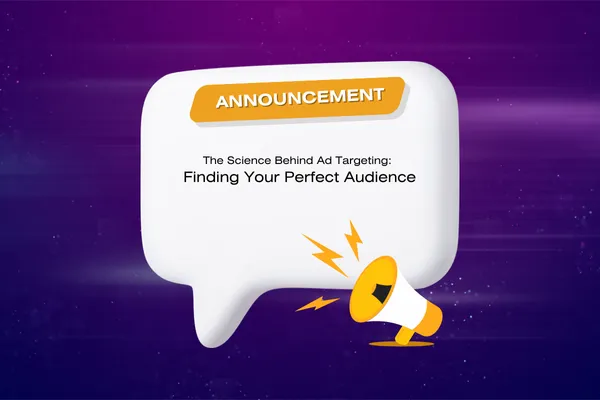
The Science Behind Ad Targeting: Finding Your Perfect Audience
Ad targeting is the cornerstone of modern digital marketing, enabling businesses to connect with audiences that are most likely to engage with their offerings. But how does ad targeting really work? What strategies and tools are involved in refining an audience to perfection? This article dives deep into the science behind ad targeting and offers actionable insights to enhance your campaigns.
What is Ad Targeting?
Ad targeting involves tailoring your advertisements to reach specific audiences based on characteristics such as demographics, behavior, interests, and location. It’s the practice of delivering the right message to the right people at the right time, powered by data-driven algorithms and user insights.
The Role of Data in Ad Targeting
Data is the foundation of ad targeting. Platforms like Google Ads, Facebook Ads, and LinkedIn Ads use a wealth of user data to help marketers pinpoint their ideal audience. Here's how:
1. Demographic Targeting
Utilizes information like age, gender, income, and education level.
Example: A luxury brand may target high-income individuals aged 30-50.
2. Behavioral Targeting
Tracks online activities such as website visits, purchases, or app usage.
Example: Retargeting campaigns focus on users who abandoned shopping carts.
3. Contextual Targeting
Matches ads to relevant content based on keywords or topics.
Example: Displaying ads for travel insurance on a travel blog.
4. Geotargeting
Targets users in specific locations, from cities to neighborhoods.
Example: Promoting a local event to residents within a 10-mile radius.
Tools for Data Collection
Google Analytics for website traffic insights.
Facebook Pixel for behavioral tracking.
CRM systems to leverage customer data for personalized campaigns.
Machine Learning and Predictive Analytics in Ad Targeting
Machine learning and AI are revolutionizing ad targeting. Predictive analytics, in particular, uses historical data to anticipate user behavior, enhancing the precision of campaigns.
Key Features of AI-Driven Ad Targeting:
Lookalike Audiences: Find new prospects similar to your best customers.
Dynamic Creative Optimization (DCO): Automatically adapts ads based on user behavior.
Personalization at Scale: Delivers unique ad experiences for different audience segments.
Examples:
Amazon’s recommendation engine suggests products tailored to user preferences.
Spotify curates ads based on users' listening habits and demographics.
The Science of Audience Segmentation
Effective ad targeting starts with audience segmentation—dividing your audience into smaller, more manageable groups. Here’s how to do it effectively:
1. Segmentation Criteria
Demographics: Age, gender, location, education.
Psychographics: Interests, values, lifestyle choices.
Behavioral: Purchase history, website interactions, brand loyalty.
2. Creating Personas
Combine segmentation data to create detailed customer personas.
Example Persona:
Name: Sarah, 34, Fitness Enthusiast.
Behavior: Shops for eco-friendly activewear.
Ad Focus: Sustainable products and discounts.
Best Practices for Effective Ad Targeting
1. Define Clear Objectives
Start with goals like increasing website traffic, boosting conversions, or improving brand awareness.
2. Leverage First-Party Data
Use your own data from CRM systems, email lists, and app interactions to understand customer behavior.
3. A/B Testing
Experiment with different ad creatives, formats, and targeting parameters to find the most effective combination.
4. Continuous Optimization
Use analytics to monitor performance and refine targeting criteria over time.
Tools and Platforms for Ad Targeting
Here are some powerful platforms to help you target your perfect audience:
1. Google Ads
Offers keyword targeting, audience insights, and retargeting options.
2. Meta (Facebook and Instagram) Ads
Enables demographic, interest, and behavior-based targeting.
3. LinkedIn Ads
Ideal for B2B campaigns with targeting options for industries, job titles, and company size.
4. Programmatic Advertising Platforms
Use AI to automate ad placement across multiple channels for maximum reach and efficiency.
Challenges in Ad Targeting
Despite its benefits, ad targeting isn’t without challenges:
1. Privacy Concerns
With regulations like GDPR and CCPA, marketers must prioritize data transparency and user consent.
2. Ad Fatigue
Overexposure to the same ads can lead to diminished engagement. Rotating creatives can help.
3. Ineffective Targeting
Poor audience definition can result in wasted ad spend. Regularly reviewing targeting criteria is essential.
Conclusion
Ad targeting is a powerful tool that combines data science, AI, and creativity to connect businesses with their ideal audience. By understanding the science behind it, using advanced tools, and continuously optimizing strategies, you can create campaigns that drive meaningful results.
